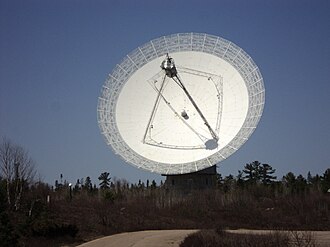Algonquin Radio Observatory
|
Algonquin Radio Observatory telescope |
|
|---|---|

|
|
| Main reflector | |
| Type | Radio telescope |
| Location | Algonquin Provincial Park, Ontario, Canada |
| Geographic coordinates | 45 ° 57 '19.8 " N , 78 ° 4' 23" W |
| wavelength | L-band, S-band and X-band. |
| Aperture | 45.8 m
|
| construction time | 1959-1966 |
The Algonquin Radio Observatory is a radio observatory in Algonquin Provincial Park in Ontario , Canada . It opened in 1959 to allow research in an electromagnetically quieter area than Ottawa . The radio telescope , built in 1966, has a 45.8 m main reflector. It is currently Canada's largest radio telescope.
history
The increasing use of radar and radio applications in the Ottawa area caused interference problems for the researchers there. This led in 1959 to the establishment of the Algonquin Radio Observatory (ARO) in Algonquin Provincial Park, approximately 150 km northwest of Ottawa, but relatively easily accessible via the major highways. A new telescope for solar flux with a 1.8 m parabolic dish was built in 1960, which was operated in parallel with the Goth Hill instrument before it fully took over its role in 1962. In 1964, an identical instrument was installed at the Dominion Astrophysical Observatory (DAO) in British Columbia . This was followed by a more powerful version of the waveguide instrument, this time focused by a series of thirty-two 3-meter bowls mounted over a 215-meter waveguide which opened in 1966.
The ARO was greatly expanded in 1966 with the commissioning of the 46 m deep space telescope. It was a major research facility in the 1960s and 1970s, although limitations in design made it less useful in the 1980s. For a while, this instrument was joined by a smaller 18-meter telescope, which was originally located at the David Dunlap Observatory outside Toronto and operated by the University of Toronto . The original solar observatories remained operational until 1990 when funding cuts at the National Research Council of Canada (NRC) forced the closure of the entire Algonquin site. In 1991, the 1.8 m bowl was implemented for use as a backup device to the DAO.
Current usage
The Canadian technology company Thoth Technology has operated the facility since 2008 . The radio telescope was completely modernized between 2008 and 2013. It is intended to serve various research areas for Canadian and international research institutions. Thoth Technology offers various geodetic services for space travel. Furthermore, the facility is an active control base for the Global Positioning System (GPS) and also belongs to the Deep Space Network . The main reflector and the receivers are able to receive and process L-band , S-band and X-band . There are also research facilities from Canadian universities such as u. a. from York University . In addition to researching new technologies, the facility will also be used as a relay and radio link for national and international space missions such as manned space missions, space probes and satellites. The radio telescope has been participating in an international research project by the Canadian Institute for Theoretical Astrophysics since 2012 . The telescope's new hydrogen maser clock achieves high levels of accuracy. New technologies in the field of long-base interferometry are to be researched.
Web links
- Website of the current operator
- Archive of the old website
- Algonquin Radio Observatory
- Space Engineering Laboratory - York University
- Canadian Institute for Theoretical Astrophysics - University of Toronto
- Canadian Mission to Mars
Individual evidence
- ↑ Technical Specifications, accessed October 4, 2019
- ↑ Canada's largest radio telescope, accessed October 4, 2019
- ↑ The restoration project, archive page accessed October 4, 2019 ( Memento from September 23, 2015 in the Internet Archive )
- ↑ The Globe and Mail - Canada's largest radio dish finds life after decades of dormancy, accessed October 4, 2019
- ↑ Prof. Pen and team Pioneer Project to Image Pulsars with Unprecedented Resolution, August 12, 2013, accessed March 4, 2014
